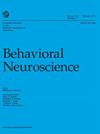Beyond reconsolidation: The need for a broad theoretical approach in clinical translations of research on retrieval-induced plasticity.
IF 1.5
4区 医学
Q3 BEHAVIORAL SCIENCES
引用次数: 0
Abstract
Experimental findings showing that retrieved memories are labile and vulnerable to disruption have led to important theoretical ideas at a basic science level that have been applied to the clinic at a translational level. At a theoretical level, these findings suggest that retrieved memories can be modulated by behavioral or pharmacological treatments as they are reconsolidated and returned to storage. At a clinical level, these findings suggest that treatments that target reconsolidation may help dampen or even erase especially problematic memories, such as those associated with trauma. However, there are many caveats to these effects and issues that need to be considered when thinking broadly about retrieval-induced plasticity and extensions into the clinic. First, performance during a memory test often does not reflect the entirety of the animal's knowledge about a situation; asking questions in different ways may reveal the presence of a memory that was thought to be eliminated. Second, although reconsolidation and extinction are often treated as competing processes, there is abundant evidence that extinction can progress through associative and nonassociative changes in the original memory that are often described in terms of reconsolidation effects. Third, targeting a reconsolidation process as a therapeutic may not be helpful in disorders like posttraumatic stress disorder, in which traumatic experiences induce a cascade of symptoms that are self-perpetuating and may ultimately maintain themselves long after trauma. Underlying all of these challenges is the need for a rich theoretical framework focused on retrieval-induced plasticity that is informed by developments in associative learning theory. (PsycInfo Database Record (c) 2024 APA, all rights reserved).超越再巩固:在对检索诱导可塑性研究进行临床转化时,需要采用广泛的理论方法。
实验结果表明,检索记忆是易变的,容易受到破坏,这在基础科学层面提出了重要的理论观点,并在转化层面应用于临床。在理论层面,这些研究结果表明,检索记忆在重新整合并返回存储时,可以通过行为或药物治疗进行调节。在临床层面,这些研究结果表明,针对重新整合的治疗可能有助于抑制甚至消除特别有问题的记忆,例如与创伤有关的记忆。然而,在广泛思考检索诱导的可塑性并将其扩展到临床时,这些效果和问题还有许多需要注意的地方。首先,在记忆测试中的表现往往不能反映动物对某一情境的全部认知;以不同的方式提问可能会发现存在被认为已经消除的记忆。其次,尽管再巩固和记忆消退通常被视为相互竞争的过程,但有大量证据表明,记忆消退可以通过原始记忆中的联想和非联想变化来进行,而这些变化通常被描述为再巩固效应。第三,以重新整合过程为治疗目标可能对创伤后应激障碍等疾病没有帮助,因为创伤后应激障碍会诱发一连串的症状,这些症状会自我延续,最终可能在创伤后很长时间内仍然存在。所有这些挑战的背后都需要一个丰富的理论框架,重点关注联想学习理论的发展所带来的检索诱导可塑性。(PsycInfo Database Record (c) 2024 APA,保留所有权利)。
本文章由计算机程序翻译,如有差异,请以英文原文为准。
求助全文
约1分钟内获得全文
求助全文
来源期刊

Behavioral neuroscience
医学-行为科学
CiteScore
3.40
自引率
0.00%
发文量
51
审稿时长
6-12 weeks
期刊介绍:
Behavioral Neuroscience publishes original research articles as well as reviews in the broad field of the neural bases of behavior.
 求助内容:
求助内容: 应助结果提醒方式:
应助结果提醒方式:


